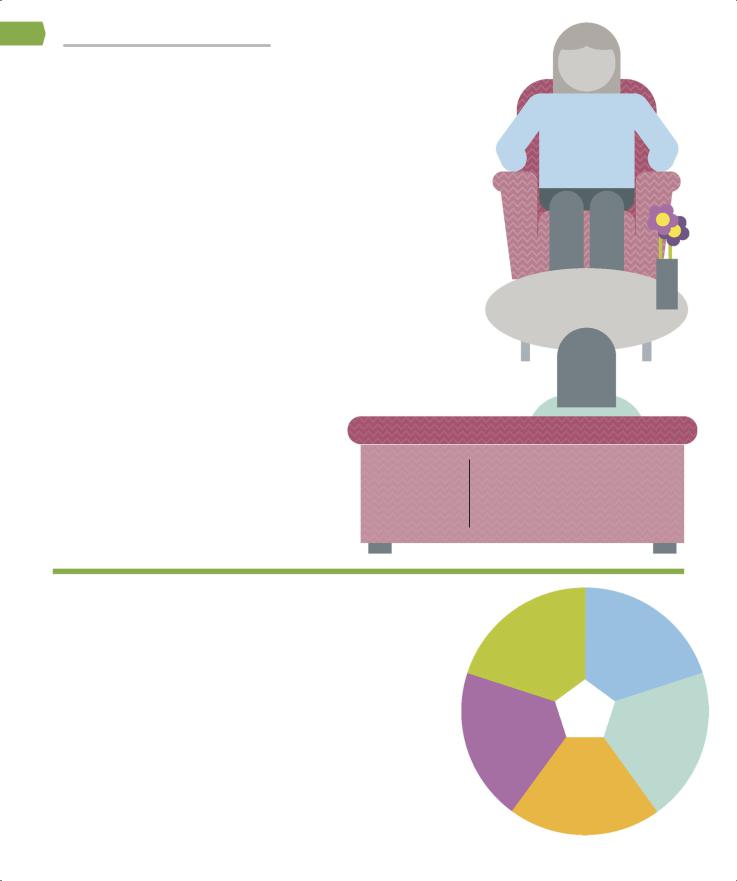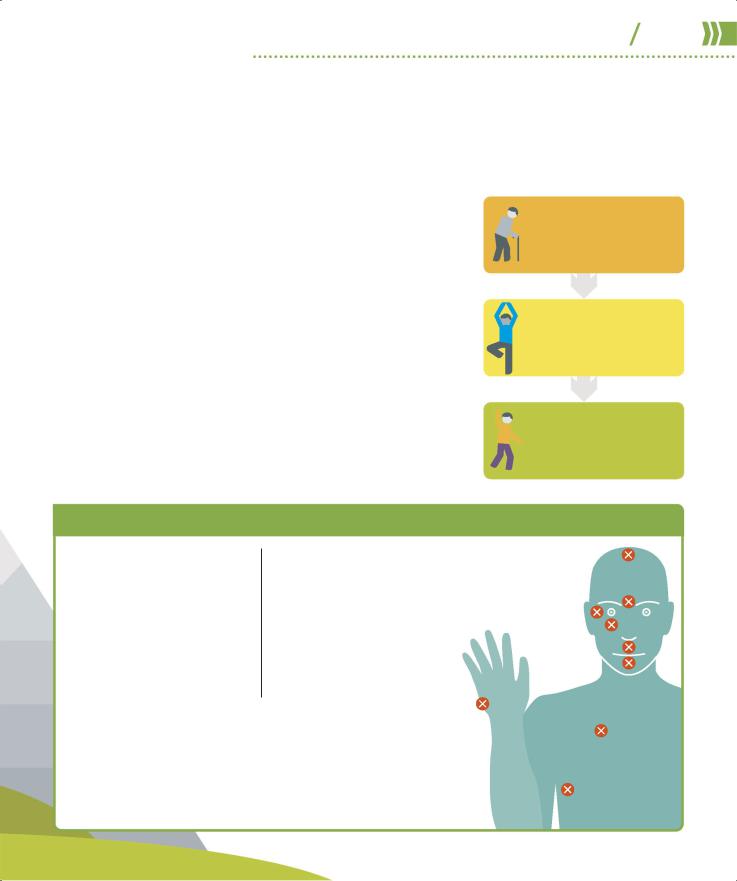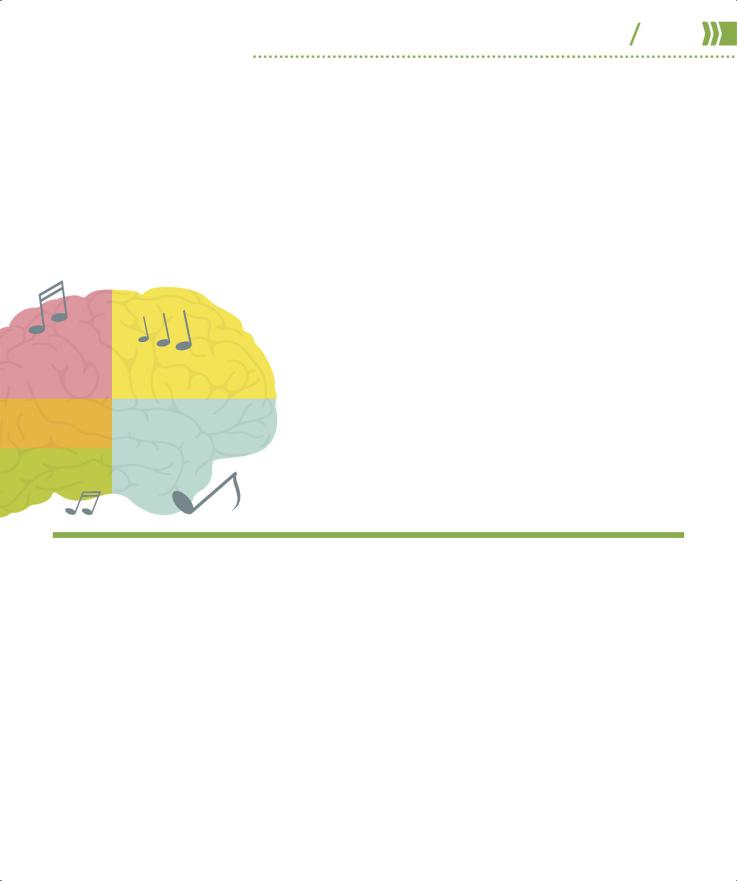
How psychology works the facts visually explained (DK) (Z-Library)
.pdf
HEALING THERAPIES |
128 129 |
Cognitive and behavioral therapies |
Mindfulness
Learning to focus awareness on the present—to observe what their thoughts, feelings, and body are experiencing at any one moment— can help people understand and manage unhelpful responses.
What is it?
Mindfulness techniques help people to give their full attention to what is happening around them and to them. Observing and accepting these experiences and sensations in a detached and nonjudgmental way gives people the space to evaluate whether thoughts and behaviors are dysfunctional, and then to modify their responses. Practices to promote mindfulness include breathing, visualization, and listening exercises; yoga; tai chi; and meditation.
Benefits of mindfulness
Learning to observe rather than be controlled by their thoughts allows people to anticipate and deal more effectively with stressful experiences and anxiety, and to replace negative thought patterns. Mindfulness exercises also have a calming effect—switching off the regions of the brain that stress turns on, and activating the parts that deal with awareness and decision-making. This allows people to focus on positive actions to promote well-being.
POSITIVE PSYCHOLOGY
Traditional psychotherapy concentrates on tackling disorders and problem behaviors; positive psychology, like humanistic therapies, focuses on the goals of selffulfillment and well-being as a catalyst for change. Learning to think positively and to focus on what brings happiness encourages people to pursue positive actions— to develop their strengths, improve their relationships, and achieve goals—on a personal and societal level. Mindfulness techniques are often used to help people focus their mind and behaviors on positive action.
PERMA model
Developed by psychologist Martin Seligman, this model for change defines the elements that promote wellbeing: (P) positive emotion; (E) engagement; (R) positive relationships; (M) meaning; and (A) accomplishments. Understanding the importance of these elements and then taking steps to pursue them through everyday thoughts and actions allows people to build on their own strengths and resources to achieve future happiness.
“... refuge to the mind is mindfulness.”
Buddha
STRATEGIES FOR MINDFULNESS
MINDFUL WALKING
Focusing your awareness on what you see, hear, and
smell; your thoughts; and the physical sensation of walking allows you to connect with the present.
MINDFUL EATING
Slowing down, taking the time to bring full attention to the process and sensation of eating, focuses your mind and can change your responses.
POSITIVE
EMOTIONS
Learning what brings happiness; positive emotions leading to positive outcomes.
MINDFUL BODY AWARENESS |
MINDFUL BREATHING |
Practicing yoga or doing a |
Learning to concentrate on the |
“body scan”—bringing your |
flow of your breath is a useful, |
attention to each part of the |
calming meditation technique |
body in turn, and noting how it |
to relieve stress, anxiety, and |
feels—focuses mind and body. |
negative emotions. |
ENGAGEMENT |
|
MEANING |
|
Complete |
|
||
|
Having a sense |
||
immersion or |
|
||
|
of purpose to |
||
“flow” in a |
POSITIVE |
||
give context |
|||
satisfying |
RELATIONSHIPS |
||
to all aspects |
|||
activity. |
Fostering a feeling |
||
of life. |
|||
|
of well-being and |
||
|
|
||
|
promoting positive |
|
|
|
emotions. |
|
ACCOMPLISHMENTS
Pursuing goals for a sense of purpose; success promoting self-esteem.

Humanistic therapies
This group of therapies encourages an individual to resolve their problems and issues and achieve greater fulfillment by recognizing, understanding, and using their own capacity to develop.
What are they?
Before humanism developed in the late 1950s, psychological issues were viewed as flaws within a person that required intensive behavioral or psychoanalytic treatment. Psychological theories relied on measurements of behavior and other scientific, quantitative (statistical) studies to evaluate and categorize people.
Humanists viewed these concrete, methodical approaches as too limited in scope to capture the broad, colorful, and individualistic human experience. In contrast with psychoanalysis, humanistic therapies view the person as a whole being able to exercise free will and make active choices, rather than as a set of predetermined drives, urges, and behaviors.
Therapists emphasize the individual’s inner strengths, resources, and potential as the foundation for working through issues. Life may be filled with challenges and heartbreak, but humans are essentially good, resilient, and capable of enduring and overcoming difficulties.
Humanists also expanded the concept of therapy as a
Therapeutic relationship
Humanistic therapists aim to cultivate a positive and constructive relationship by valuing their client, and showing genuine, unconditional, positive regard. This environment nurtures the client’s
self-knowledge, confidence in their own choices, and emotional development so that they can self-actualize (fulfill their own potential).
NURTURING ENVIRONMENT
Constructive atmosphere to help client put down
roots and flourish.
|
|
|
|
|
|
THERAPIST |
|
|
|
|
|
||||||||||
|
|
|
|
|
|
awareness |
|
|
|
PROMOTES |
|||||||||||
|
|
|
|
Self |
|
|
|
|
|
|
|
|
|
|
|
|
|
|
|
||
|
|
|
to |
|
- |
|
|
|
|
|
|
|
|
|
|
|
|
|
|
|
|
|
|
|
availableacknowledge |
|
|
Aims |
to |
|
|
|
|||||||||||
|
their |
|
|
|
to |
|
|
|
the |
|
|
|
enable |
|
|||||||
|
Self |
|
own |
|
them, |
|
|
|
|
|
|
|
|||||||||
|
|
- |
|
|
|
|
|
andpersonal |
choices |
||||||||||||
|
|
|
|
|
|
|
|
motivations |
|
to |
|
|
|||||||||
allow |
acceptance |
|
|
|
|
|
|
|
|
client |
|||||||||||
|
|
|
|
and |
|
|
|
|
|||||||||||||
them to |
|
|
Values |
|
|
understand |
|||||||||||||||
|
|
|
|
|
|
|
|
||||||||||||||
promotes |
|
|
|
|
|
|
|
goals. |
|
||||||||||||
|
- |
|
|
|
|
selfaccept |
|
|
|
|
the |
|
|
|
|||||||
Self |
|
|
|
|
|
|
|
|
|
|
|
|
|
|
|
|
|
|
|
|
|
the clientfulfillmentregard andthemselves,client to |
|
||||||||||||||||||||
abilities |
|
to |
|
|
and |
|
|
|
|
|
|
- |
|
and |
|
||||||
|
|
|
|
harness |
|
|
|
|
|
self |
belief. |
|
|||||||||
|
|
|
and |
|
|
growth |
|
|
|||||||||||||
developmentresourcestheir |
|
|
|
|
Helps |
|
|
||||||||||||||
|
|
|
|
|
and |
|
|
for |
|
innate |
|
|
|
|
|||||||
|
|
|
|
|
|
|
|
improvement. |
|
|
|
|
|
||||||||
|
|
|
|
|
|
|
|
|
|
|
|
self |
|
|
|
|
|
|
|
||
|
|
|
|
|
|
|
|
|
|
|
|
|
|
- |
|
|
|
|
|
|
|

HEALING THERAPIES |
130 131 |
Humanistic therapies |
treatment for severe neuroses to a broadly applicable approach for anyone wanting to self-improve. They recognized people’s natural desire to overcome problems, seek happiness, improve the world, and live a satisfying and fulfilling life as the primary, central human motivation. An individual’s need to realize their potential and fulfill their goals and dreams is called self-actualization.
Humanists believe that not only is a person capable of making changes and achieving personal growth but it is their
responsibility to do so. This idea places the individual fully in control of their choices and goals.
Humanistic approaches for getting to know a client are as creative and diverse as people themselves, but all are based on talking and trust. In a session, rather than relying on their own observations, the therapist asks open-ended questions and listens to what the client makes of their own behavior and personality. All humanistic therapists use their
empathy and understanding to help the client accept themselves.
NEED TO KNOW
Therapist/client relationship
In close and collaborative counseling, the therapist encourages the client to use their own resources to find solutions.
Qualitative methods Rather than evaluating behavior with a questionnaire (a quantitative method), listening is the basis of
therapy, as the client is seen as the expert in their own experiences. The therapist guides the client toward greater self-awareness.
“[A person is] a continuing constellation
of potentialities, not a fixed quantity of traits.”
CLIENT |
|
|
|
|
|
Carl Rogers, American humanistic |
||||
|
|
|
|
|
psychologist |
|||||
Self- |
|
|
ACHIEVES |
|
||||||
or |
actualization |
|
|
|
||||||
|
wishes, |
realizes |
|
|
Attains their |
|
||||
becomes |
|
|
|
goal |
||||||
|
|
their |
|
their |
potential, |
|||||
|
|
|
|
|
ideal |
self. |
and |
|||
|
|
|
|
|
|
|
|
|||
CLIENT ENGAGES WITH THE PROCESS
Responsibility Takes active role to make the changes needed for personal growth; therapist helps the individual take responsibility for their choices, behaviors, and self-development.

HUMANISTIC THERAPIES
Person-centered therapy
In this approach, the accepting, supportive relationship between therapist and client promotes self-belief, confidence, and personal growth.
What is it?
True to humanism, person-centered therapy holds that all people possess the resources they need to gain insight, experience personal growth, and change their attitudes and behaviors to reach their full potential—self-actualization.
Therapy sessions focus on the present and future, rather than on the past, and the client leads the conversation. The therapist listens intently to the client’s experiences, responding without judgment.
The authenticity and depth (congruence) of this relationship encourages clients to express their thoughts and emotions freely. The therapist’s unconditional positive regard validates the client’s feelings, attitudes, and perspective, and the therapist’s acceptance
allows the client to truly accept themselves. Self-esteem, selfunderstanding, and confidence improve; guilt and defensive reactions lessen.
Self-acceptance allows clients to have more faith in their abilities, express themselves better, and
improve their relationships, and can also help with body perception in people with dysmorphic disorders.
CLIENT/ |
CONGRUENCE |
|
The therapist is |
||
THERAPIST |
||
positive, optimistic, |
||
RELATIONSHIP |
||
and genuine. |
||
The therapist |
||
|
||
is the vehicle |
|
|
for the client’s |
|
|
self-improvement. |
|
THE CLIENT
SELF-
ACTUALIZATION
Client uses their inherent capacity and desire for personal growth and change.
Therapist creates climate to facilitate change.
THE THERAPIST |
|
|
UNCONDITIONAL |
|
EMPATHY |
|
||
REGARD |
|
The therapist |
The therapist sees the |
|
understands and |
client in a positive |
|
experiences the |
light, enabling the |
|
world through the |
client to do the same. |
|
eyes of the client. |
Reality therapy
This problem-solving therapy seeks to help the client evaluate and change their current behaviors and thought processes. It is especially useful for relationship issues.
What is it?
In reality therapy, the therapist helps a client change how they act, then how they think, as both behaviors are easier to control than how they feel or react. The therapy holds that the only behavior an individual can control is their own, which is motivated by
the five basic needs (right). Focus is on the present. The therapist discourages criticizing, blaming, complaining, and excuses, all of which harm relationships. Instead, client and therapist together identify and monitor behavior patterns and create a workable plan of change.
Fun |
Physiological |
||
Pleasure, |
|
(survival) |
|
fulfillment, |
|
Food, shelter, |
|
and joy |
|
and safety |
|
|
FIVE |
Love and |
|
Freedom |
BASIC |
||
belonging |
|||
Autonomy and |
NEEDS |
||
control over |
|
Part of a family, |
|
|
network of friends, |
||
own life |
|
||
Power |
or community |
||
|
|||
|
To succeed, |
||
provide, feel competent, and be recognized for accomplishments

HEALING THERAPIES |
132 133 |
Humanistic therapies |
Existential therapy
This philosophical therapy helps people come to terms with the specific, inherent challenges of simply existing by making choices and taking responsibility for their actions.
What is it?
Existential therapy is based on the premise that if people make peace with the givens of existence (right), they can lead a more fulfilling and enjoyable life, free from anxiety.
Existentialism holds that people have free will and are active participants in their own lives. Therapy focuses on increasing self-awareness by exploring the meaning, purpose, and value in the client’s life, and by helping them understand that they are in charge and not just a passive victim of
drives and impulses. A session may address questions such as “Why are we here?” and “How can life be good if it involves suffering?” and “Why do I feel so alone?”
By learning to accept responsibility for decisions in the past that led to emotional disruption, the client gains the power to take control of their experiences. The therapist helps
the client find individual, nuanced solutions; and acceptance, growth, and welcoming future possibilities are key themes.
THE GIVENS
OF EXISTENCE
The inevitability of death The natural drive to exist conflicts with awareness that death is inevitable.
Existential isolation Everyone enters the world alone and leaves it alone. Regardless of any relationships or connections, people are innately alone.
Attendant isolation People are alone, yet seek connection.
Meaninglessness People seek purpose, yet finding a path and understanding the meaning of existence often eludes them.
Freedom and responsibility
All have a responsibility to create their own purpose and structure, as existence inherently has none.
Gestalt therapy
This lively and spontaneous therapy liberates clients and helps them become more aware of their thoughts, feelings, and behavior and their effect on their surroundings.
What is it?
The German word gestalt roughly translates as “whole,” reflecting the belief that the individual is more than the sum of their parts and has a unique experience of the external world. Gestalt therapists believe that discussion alone cannot alleviate guilt, unresolved anger, resentment, or sadness. The client must evoke and experience negative feelings in the present to resolve them. The therapist may use role-play, fantasy, visualization, or other stimuli to arouse negative feelings from the past so that the
client gains insight into how they react to certain situations. This increased self-awareness allows the client to identify patterns and see the true, rather than perceived, effect of their behavior.
Gestalt was developed to treat addiction but helps depression, grief, trauma, and bipolar disorder, too.
EMPTY-CHAIR TECHNIQUE
The client addresses a chair as if it is an important figure in their life,
then changes roles to understand the opposing view. Releasing feelings and emotions increases self-awareness.
ENACTMENT
LEADS TO
SELF-AWARENESS

HUMANISTIC THERAPIES
Emotion-focused therapy
This approach attempts to help people understand their emotions better and acknowledge them, and to use this newfound self-awareness to guide their behavior.
What is it?
This therapy is based on the premise that emotions form the foundation of people’s identity and govern their decision-making and behavior. With this approach, the client is encouraged to discuss and analyze how they feel or have felt in past situations to identify which emotions are helpful or unhelpful to them and to make sense of their emotional responses.
Increasing awareness allows the client to describe their emotions more clearly, to assess whether the
feelings are appropriate to the situation, and to learn to use positive emotions to guide their actions. Recognizing how unhelpful emotions, including those linked to traumatic experiences, negatively impact choices and behavior also helps the client to regulate these feelings and to develop strategies to change their emotional state.
Strategies may include using breathing techniques, using imagery and visualization, repeating positive phrases, or using new experiences to elicit positive emotions.
EMOTIONALLY FOCUSED THERAPY
Although its title is similar, emotionally focused therapy is different from emotion-focused therapy. It is a relationship therapy for couples and families to help them understand the emotions that govern their interactions. Because negative patterns of behavior and conflict can occur when emotional needs are not met, the therapist helps clients recognize their own feelings and acknowledge those of family members or partners. Learning how to express and regulate emotions, listen to others, and positively use emotion tightens bonds with partners or family members, resolves past issues, and offers strategies for the future.
Solution-focused brief therapy
This forward-looking therapy encourages individuals to focus on their strengths and to work positively toward achievable goals rather than dwelling on or analyzing the past.
What is it?
This therapy is based on the belief that everyone has the resources to improve their lives but may need help in structuring plans. The so-called miracle question (“How is life different if ...?”) is often asked so the person envisions what life will be like when their issue is resolved. From here, the individual can define a goal, create possible solutions, and outline specific steps to achieve their goal. Coping questions, such as “How have you handled this in the past?” also
encourage the person to focus on previous successes, showing them that they already have the skills, resourcefulness, and resilience
to achieve a positive outcome. Therapy usually involves about
five sessions. While the therapist provides accountability and support, the client is always considered to be the expert on their own problems. It is a particularly effective method for young people, who may prefer a short, structured approach rather than a probing analysis of their past.
REACH
GOAL/
DESIRED
SITUATION
ASSESS WHAT
HAS ALREADY
BEEN ACHIEVED
SCALE HOW CLOSE THE GOAL IS AND DECIDE ON SMALL REALISTIC STEPS
DESCRIBE THE GOAL IN DETAIL AND PICTURE A SOLUTION
DECIDE ON A CLEAR AND REALISTIC GOAL

HEALING THERAPIES |
134 135 |
Humanistic therapies |
Somatic therapies
These therapies—based on the idea that unresolved emotional issues are stored physiologically as well as psychologically—act on the body to release negative tension and restore mental health.
What are they?
Sometimes psychological healing occurs through methods that cannot be entirely explained, yet are still effective. This is true of many mind-body healing therapies, sometimes called energy psychology, which deal holistically with the body and mind.
Somatic therapies consider that the integration of mind and body is essential for mental health.
Massage, body work, breath work, yoga, tai chi, and the use of essential oils or flower essences are all examples of somatic therapies that may relieve physical and emotional tension.
Certain body parts are associated with psychological issues. Many people carry stress in their shoulders, for instance, and emotional trauma may create physical pain or digestive problems. Changing body posture can change the psychological experience—a broken heart, for example, often leads to a shoulders-forward, heart-protected slouch, and a sense of defeat results in a downward gaze. Encouraging the client to thrust their shoulders back, sit up straight, and lift their chin to the sky can help them to feel powerful, more optimistic, and more open to facing the world.
Trauma destabilizes the autonomic nervous system. Psychological issues are stored in body and mind.
Yoga and other somatic therapies restore balance by releasing negative emotions held in the body.
The healing power improves the person’s state of mind and reduces physical symptoms of pain.
EMOTIONAL FREEDOM TECHNIQUE
This holistic therapy works on the same meridians (energy channels) as acupuncture and acupressure. The theory is that traumatic experiences can block these channels, causing continuing distress. The therapist uses their fingertips to tap meridian points on the body, while the client thinks about a specific problem, image, or negative feeling, and voices positive affirmations.
Tapping these points appears to calm the amygdala—the part of the brain that processes emotions and controls the fight-or-flight response. Over time, this process reprograms
the individual’s thoughts, removing negative emotions and replacing them with new, positive feelings and behaviors. Individuals can also learn to perform the tapping sequence themselves.
TAPPING POINTS |
1 |
After the karate-chop |
|
points are tapped, |
|
meridian points are |
2 |
tapped from the head |
|
downward, 1–8. |
|
3 |
4 |
5
6
of individuals report a |
7 |
|
|
80%positive effect from EFT |
8 |

HUMANISTIC THERAPIES
EMDR (eye movement desensitization and reprocessing)
This therapy stimulates the brain using eye movement, reprocesses traumatic memories so that they lose their power to disturb, and teaches the client techniques to deal with emotional disturbances.
What is it?
In this therapy, the client recalls a picture, scene, or feeling from a
past trauma while tracking bilateral stimulation, such as the therapist’s hand moving back and forth across their field of vision. The client thinks of a negative statement linked to the trauma (for example, “I am unworthy,” from a childhood marred by a disapproving parent) and replaces it with a positive, preferred self-statement.
Based on the idea that the negative belief system has been trapped in the client’s nervous
DURING BILATERAL STIMULATION, side-to-side eye movements help the brain to digest traumatic memories, and reorganize how they are mentally stored.
system, even though the actual danger has long since passed, the combination of eye movement and psychological recall neurologically releases the traumatic memory and its negative effects. This allows the memory to be stored neutrally, and helps install a new healthy belief system.
The process mimics the memory processing and physical movement thought to occur during REM (rapid eye movement) dream sleep. The therapy is particularly effective in treating individuals with PTSD (p.62) and symptoms
can be significantly reduced in as few as three 90-minute sessions.
Hypnotherapy
During hypnotherapy, the client enters a deep, trancelike state of relaxation that suppresses the conscious mind, allowing the subconscious to become more alert and receptive.
What is it? |
changing the client’s perceptions, |
childbirth or surgical or dental |
The therapist uses the power of |
thought processes, and behavior. |
procedures. Another use is to allow |
hypnotic suggestion to quiet the |
Hypnotherapy is particularly |
suppressed or hidden memories to |
analytical parts of the brain and |
useful for helping clients to |
surface so that the related issues |
fully focus the client’s attention |
overcome unwanted habits such |
and emotions can be addressed. |
on the subconscious mind. Once |
as smoking or overeating. It can |
Clients practice deep relaxation, |
the client is deeply relaxed, the |
also be used to reduce pain in |
often using a recording taped by |
therapist makes suggestions that |
future situations that the client |
the therapist between sessions to |
instill different brain patterns, |
anticipates will be painful such as |
consolidate the work. |

HEALING THERAPIES |
136 137 |
Humanistic therapies |
Arts-based therapies
These approaches use the alternative languages of art and music to promote self-discovery, self-expression, and well-being. They can help people articulate thoughts and feelings and regulate their emotions.
What are they?
It can be difficult for some people to find words to express emotions and perceptions. Art therapy provides a way for them to describe their inner
ACTIVATES |
|
REWARD |
AIDS PROCESSING OF |
NETWORK |
SOCIAL AND EMOTIONAL |
IN BRAIN |
INFORMATION |
ENHANCES |
REGULATES HEART RATE, |
COGNITION |
MOVEMENT, BREATHING, |
|
AND SPEECH |
AIDS |
|
COMMUNICATION |
|
life, investigate and validate thoughts and feelings, and increase self-awareness. The physical act of producing art can be therapeutic in itself too, as it concentrates body and mind on a single creative goal.
The focus in art therapy is not on the skill of the artist, but
on the creative process as a form of communication.
Displaying their art in public can help individuals overcome their self-consciousness and selfcriticism and lead to greater acceptance of themselves and improved self-esteem.
Music therapy plays a different role. When music stimulates the brain (left), it activates a myriad of sensory connections, which can
change the individual’s physical and emotional states. Music acts on neural pathways throughout the brain to alter how a person processes information, experiences and expresses emotions, uses language, relates to others,
and moves.
Music can promote long-term behavioral and emotional changes, including decreasing symptoms of depression and anxiety. Its physiological effects include triggering the release of moodenhancing chemicals, such as
dopamine, and lowering heart rate. All styles of music can be used, and sessions may involve listening
to music, using instruments, singing, improvising, or composing.
Animal-assisted therapy
This approach uses the bond between people and animals to improve communication skills, emotional control, and independence, and to decrease feelings of loneliness and isolation.
What is it?
Interacting with animals increases levels of oxytocin, a hormone that promotes intimacy and trust, and mood-enhancing endorphins. Learning how to handle animals also improves behavioral and social skills and boosts self-esteem.
Stroking cats, looking after dogs or horses on a regular basis, and swimming with dolphins are some
of the ways vulnerable people can learn about boundaries, respect, and trust and develop self-reliance and independence. In anger-management and substance-abuse group therapy,
the presence of animals can encourage participants to open up and talk about lost innocence and violent pasts, leading to greater self-acceptance and forgiveness.
“A pet is a medication without side effects.”
Dr. Edward Creagan,
American oncologist

Systemic therapies
These approaches recognize that people are part of a network of relationships that shape their behaviors, feelings, and beliefs. The therapies seek to influence the whole system, not just the individual.
What are they?
Systemic therapies make use of the concepts of systems theory, which hold that any individual object is just one part of a larger and more complex system. In human terms, this might be a family, workplace, organization, or social community.
Disruption in one part of the system may affect or unbalance other parts of the network. For example, a person experiencing depression may find that it disrupts their relationships with family members, but it may also affect interactions with work colleagues and friends. Rather than treating the problems of the individual
in isolation, systemic therapies therefore tackle them in the context
of the system as a whole— looking for solutions that work for everybody. Making a change to one part of the system—such
as providing better support for the individual at work—can benefit all members of the network.
As well as viewing the system as a whole, these therapies address system dynamics, attempting to identify deeply entrenched patterns and trends. The dynamics of many families, for example, are governed by a series of unwritten rules and unconscious behaviors.
By making individuals aware of the ways in which they interact and influence one another, these therapies help people to make positive changes that benefit the dynamics of the group. This
involves considering the perspectives, expectations, needs, and personalities of all the people involved, and encouraging dialogue to enable each person to gain an insight into the roles and needs
of others in the group.
To resolve issues, all members of the group have to accept that change is needed and recognize how their actions influence others. In many cases, small individual changes can lead to large shifts in group behavior.
Looking at problems systemically also reveals how seemingly unrelated issues can be closely
linked. Solving one issue may therefore bring the bonus of a beneficial effect on
other parts of the system.
“The family crucible must have a shape, a form, a discipline of sorts, and the therapist has to provide it.”
Augustus Napier, American author and family therapist
When conflict occurs between two people, they |
CONFLICT |
Balancing relationships |
|
may focus on a third person as a way to stabilize |
|
their relationship, rather than resolving the issue |
|
between themselves, so emotional relationships |
|
can be seen to be triangular. Adding a third |
|
person into an existing relationship (for example, |
|
the arrival of a baby) is not always beneficial and |
|
may cause friction between the original two. |
|
HARMONY
EMOTIONAL
TRIANGLE
HARMONY
